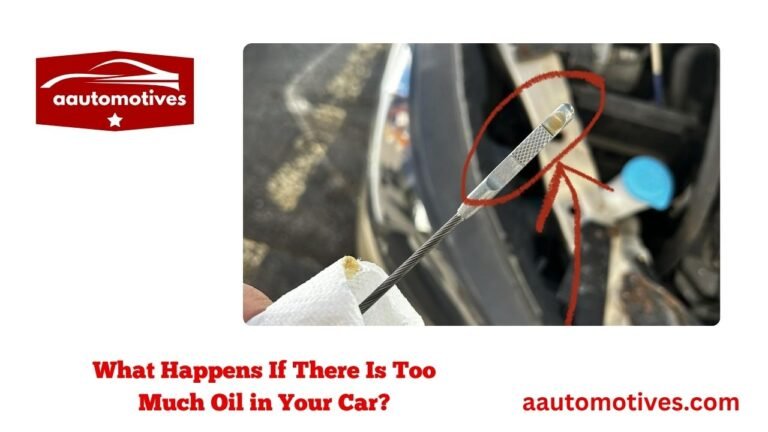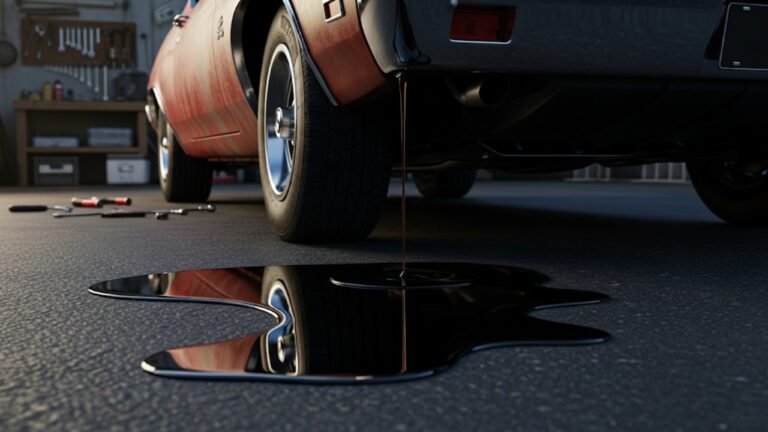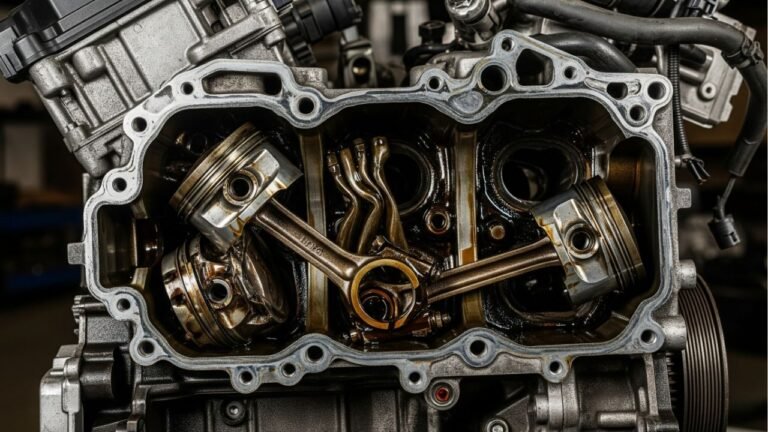How Can You Tell If You Put Too Much Oil in Your Car?

Let’s be real for a second.
We’ve all done it or come close—pouring a bit too much engine oil while topping off our cars. You’re standing in the driveway, oil bottle in hand, thinking, “A little extra can’t hurt, right?”
Wrong.
Overfilling engine oil might seem harmless. But it can cause a chain reaction of car problems, from engine damage to strange noises and even costly repairs. That’s why knowing how can you tell if you put too much oil in your car is super important—even if you’re just a weekend DIYer.
In this guide, I’ll break it down in plain language. We’ll go over real symptoms, what they mean, and how to handle the situation without panicking. Think of it like a conversation between car-savvy friends.
Let’s dive into the warning signs your car gives when it’s drowning in oil.
In This Article
- 1 Why Too Much Oil is a Bigger Problem Than You Think
- 2 1. Engine Oil Dipstick Tells the First Truth
- 3 2. Smoke from the Exhaust: Your Car’s Cry for Help
- 4 3. Oil Leaks and Puddles Under the Car
- 5 4. Engine Runs Rough or Misfires
- 6 5. The Check Engine Light Suddenly Appears
- 7 6. Weird Sounds: Knocking, Ticking, or Gurgling
- 8 7. Oil Pressure Gauge Fluctuates
- 9 8. What Happens If You Keep Driving with Too Much Oil?
- 10 9. How to Fix the Problem: Draining the Extra Oil Safely
- 11 10. Can Overfilling Once Cause Permanent Damage?
- 12 11. Preventing This in the Future: Simple Habits That Work
- 13 12. Real Stories: You’re Not Alone
- 14 Conclusion: Trust the Signs, Trust Yourself
Why Too Much Oil is a Bigger Problem Than You Think

When you overfill your engine, it can’t breathe properly. That excess oil gets whipped into foam by moving parts. Foamy oil loses its ability to lubricate. The engine parts start rubbing, and heat builds up. That’s a recipe for wear, tear, and sometimes even total failure.
Here’s what too much oil can lead to:
-
Increased crankshaft pressure
-
Oil leaks from seals and gaskets
-
Frothy oil, reducing lubrication
-
Catalytic converter damage
-
Smoke from the exhaust
-
Engine knocking or misfiring
These aren’t just theoretical risks. I learned the hard way when I added half a quart too much to my old Honda Civic. A week later, it started coughing up white smoke like a dragon.
Let’s explore what signs to look for so you can stop the damage before it starts.
1. Engine Oil Dipstick Tells the First Truth
The very first thing you should do if you suspect too much oil? Check your dipstick.
Most cars have a dipstick with markings showing the safe oil range. After letting your engine cool down for at least 10 minutes, pull it out, wipe it clean, and insert it again.
Now read the oil level.
If it’s above the MAX or FULL line, you’ve got your answer.
Quick Tip: Make sure your car is parked on level ground. Tilted measurements can throw off the reading.
Here’s a simple table to understand your dipstick reading:
| Oil Level on Dipstick | What It Means | What to Do |
|---|---|---|
| Below MIN | Too little oil – top off ASAP | Add recommended amount |
| Between MIN and MAX | Perfect range | No action needed |
| Slightly above MAX | Borderline overfilled – monitor | Consider draining a small amount |
| Far above MAX | Definitely too much oil | Drain excess oil immediately |
How can you tell if you put too much oil in your car? The dipstick is your best friend.
2. Smoke from the Exhaust: Your Car’s Cry for Help
If you’ve recently topped off your oil and notice thick white or bluish smoke from your tailpipe, your car is literally crying out for help.
What’s happening is that excess oil is getting into the combustion chamber or the exhaust system. Instead of burning fuel cleanly, the engine burns oil—and you see it as smoke.
This is exactly what happened to my cousin’s Toyota. He added a full quart extra “just to be safe.” Within two days, the car puffed like a steam engine. Not only did it reek of burning oil, but it also triggered the check engine light.
Watch for:
-
A burning oil smell
-
Smoke that gets worse as the engine warms up
-
Oil drops near the tailpipe
If you see or smell this, it’s time to take action—fast.
3. Oil Leaks and Puddles Under the Car
Another easy-to-miss sign?
Oil dripping under your car.
When there’s too much oil, the pressure inside the engine increases. That pressure finds any weak spot in the gaskets or seals—and forces oil out. You may see a puddle under the engine after parking for a while.
This happened to me once after a rushed oil change. I was in a hurry, didn’t double-check the level, and left town for a few days. When I came back? A small pool of dark gold was waiting for me on the garage floor.
Here’s what to do:
-
Wipe the oil off the engine and floor
-
Park the car in a clean spot
-
Monitor for leaks over 24 hours
If the puddle returns, you likely overfilled your oil.
4. Engine Runs Rough or Misfires
How can you tell if you put too much oil in your car? Another dead giveaway: your car starts acting weird while driving.
-
Rough idling
-
Loss of power
-
Engine stutters or misfires
Why? Because too much oil interferes with spark plug function. Oil can seep into the combustion chamber, soak the plugs, and ruin the air-fuel balance.
That’s a real pain. You’ll feel your car vibrating more than usual. Sometimes, it might stall at traffic lights or sound like it’s choking.
If this happens after a recent oil change, your oil level should be the first thing you check.
5. The Check Engine Light Suddenly Appears
Nothing kills a smooth ride like seeing that amber “Check Engine” light pop up.
One overlooked reason? Too much oil in the engine.
When sensors detect irregularities—like a misfire or bad air-fuel mix—they send warnings. The ECU (Engine Control Unit) responds by illuminating the light.
Although the check engine light can mean many things, if it appeared right after you topped off your oil, that’s a big clue. It happened to me once on a road trip. I overfilled before leaving, and halfway through the journey, the check engine light came on. I pulled into a rest stop, checked the dipstick, and sure enough—it was over the line.
Don’t ignore that light. It’s trying to save your engine from long-term damage.
6. Weird Sounds: Knocking, Ticking, or Gurgling
Engines are usually quiet—just a gentle hum and purr. But overfilling oil can make them noisy and strange.
When you put too much oil, the crankshaft spins and churns the oil into foam. That foam is full of air bubbles—and air doesn’t lubricate.
This results in:
-
Knocking sounds from inside the engine
-
Ticking noises as components struggle to move
-
Gurgling or sloshing from the oil pan
It’s like your engine is asking, “What did you do to me?!”
Trust your ears. If something sounds off, investigate immediately.
7. Oil Pressure Gauge Fluctuates
Many modern cars have a dashboard oil pressure indicator or gauge. While not always available in compact models, this little tool is useful.
If you notice the oil pressure is too high or jumping around, that’s another sign you’ve put in too much oil.
Too much oil increases pressure beyond the system’s limit. The oil pump struggles, and your gauge reflects the chaos.
Here’s a basic way to read oil pressure behavior:
| Oil Pressure Reading | What It Suggests |
|---|---|
| Normal & steady | Oil level likely fine |
| Low or dropping fast | Possibly too little oil |
| High or jumping | Potential oil overfill |
It’s subtle but important. Especially in high-mileage vehicles, you don’t want your oil system working overtime.
8. What Happens If You Keep Driving with Too Much Oil?
Now here’s the big question: What if you ignore the signs and keep driving?
The short answer? You’re asking for trouble.
Over time, too much oil does more than just make your engine messy—it starts damaging vital components. That extra oil builds pressure in places it shouldn’t. Your seals and gaskets—like tiny gatekeepers—aren’t built to handle the overflow. They begin to leak.
Then things go from bad to worse.
Prolonged driving with excess oil can lead to:
-
Spark plug fouling (resulting in more misfires)
-
Clogged catalytic converter (a very expensive fix)
-
Rod and bearing damage
-
Engine overheating (due to reduced oil flow)
-
Full engine failure in extreme cases
I once ignored the ticking sounds in my Nissan Altima for two weeks. Thought it was just “old car noises.” But it turned out I had overfilled the oil, and that ticking turned into a complete stall on the highway. The repair? $900 and two days in the shop.
If you ever feel like “it’s probably fine,” don’t wait. Check it. Fix it. Save your car from something worse.
9. How to Fix the Problem: Draining the Extra Oil Safely
So, you’ve confirmed you added too much oil. Now what?
The solution is pretty simple: remove the excess oil. You have two main options—do it yourself or take it to a shop.
Option A: Do It Yourself (DIY Method)
If you’re comfortable under the hood, here’s how to go about it:
Tools You’ll Need:
-
Oil drain pan
-
Socket wrench
-
A clean rag
-
Latex gloves
-
Optional: turkey baster or fluid extractor (for dipstick tube method)
Steps:
-
Let the engine cool down.
-
Slide under the car and locate the oil drain plug.
-
Place your pan underneath and slowly loosen the plug.
-
Let just a small amount of oil drain (around 200–300 ml at a time).
-
Tighten the plug and check the dipstick again.
-
Repeat until the level is just below or on the MAX line.
Pro tip: If you’re squeamish about going underneath, you can use a fluid extractor from the top through the dipstick tube. It’s slower, but cleaner.
Option B: Let a Mechanic Handle It
If you’re not into messy work or lack the tools, head to a local mechanic. They can drain and dispose of the oil properly and safely. Plus, they’ll check for any damage while they’re at it.
The cost? Around $20–$50, depending on location. Worth it for peace of mind.
10. Can Overfilling Once Cause Permanent Damage?
This is a common worry. You realize your mistake, fix it quickly, but still feel anxious. Totally normal.
Here’s the good news: If caught early, minor overfilling usually won’t cause lasting harm.
But there’s a catch.
If you:
-
Drove with excess oil for hundreds of miles
-
Noticed serious smoke, knocking, or leaks
-
Ignored the check engine light
…then some damage might already be done—especially to the catalytic converter, spark plugs, or gaskets.
To be safe, consider getting a quick inspection. A mechanic can check the spark plugs, compression, and oil system health.
Think of it like getting a health checkup after a bad week of eating—better safe than sorry.
11. Preventing This in the Future: Simple Habits That Work
Now that we’ve handled the problem, let’s keep it from happening again.
It only takes a few good habits to avoid the whole mess:
Know Your Oil Capacity
Every car has a specific oil capacity—usually listed in the owner’s manual or online. Memorize it or write it down. Don’t “eyeball” it.
Add Oil Slowly
Pour small amounts, check the dipstick, and repeat. Adding a little at a time is safer than pouring the whole bottle in one go.
Use a Funnel
Avoid spills and overpours by using a cheap plastic funnel. It helps control flow, especially with full quart bottles.
Change Oil, Don’t Just Top Off
If your oil looks dirty, topping off is just delaying the inevitable. A full oil change helps you start fresh—clean, accurate, and safe.
Track Your Oil Changes
Use a small notebook or phone app to log oil changes and how much you used. It becomes a helpful reference next time.
Bonus tip: If you’re ever unsure, add 75% of the recommended oil, check, and top off slowly. Safer than guessing.
12. Real Stories: You’re Not Alone
You’d be surprised how many people have overfilled their oil and panicked afterward. Here’s a quick peek at some relatable moments:
-
Tariq from Dallas: “My new job started the next day. In a rush, I added way too much oil. The next morning, my car wouldn’t even start.”
-
Maya in Florida: “I did my first oil change alone. Watched five YouTube videos. Still added an extra quart. Luckily, my neighbor helped me drain it.”
-
Ravi from Mumbai: “Thought more oil = smoother engine. Learned the hard way after white smoke came pouring out during a date. Super embarrassing.”
These stories remind us—we’re all human. Cars don’t come with feelings, but they sure react when we treat them wrong.
Conclusion: Trust the Signs, Trust Yourself
Let’s bring it home.
How can you tell if you put too much oil in your car? Easy: your car tells you. You just have to listen. Whether it’s smoke, rough driving, puddles, or warning lights—these signs are your guide.
Oil is essential. But like all good things, moderation matters.
So next time you grab that oil bottle, breathe, measure, pour slowly, and double-check.
Because catching an overfill early could save you hundreds—maybe thousands—in repairs.
And if you’ve already made the mistake? It’s okay. Now you know what to do. Handle it like a pro, learn from it, and get back on the road with confidence.
Your car will thank you.






